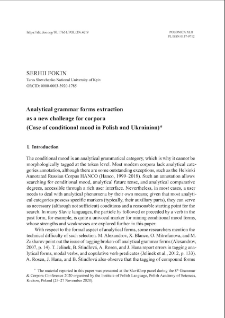- Search in all Repository
- Literature and maps
- Archeology
- Mills database
- Natural sciences
Advanced search
Advanced search
Advanced search
Advanced search
Advanced search

Object
Title: Wydobywanie form gramatycznych analitycznych jako nowe wyzwania korpusowe (na materiale form trybu przypuszczającego w języku polskim i ukraińskim)
Wydawca:
Miejsce wydania:
Data publ. on-line:
Typ obiektu:
Bibliografia:
Alexandrov, M., Blanco, X., Mitrofanova O.M., & Zakharov, V. (2007). Nooj Applications for Document Clustering and Corpus Linguistics. In X. Blanco, & M.Silberztein (Eds.), Proceedings of the 2007 International NooJ Conference (pp. 6–19). Newcastle: Cambridge Scholars Publishing. https://www.cambridgescholars.com/download/sample/60082 Conditional Marker Auxiliaries, https://universaldependencies.org/pl/dep/aux-cnd.html (accessed: 28.10.2022).Conditional Mood Tagset, https://universaldependencies.org/u/feat/Mood.html (accessed: 28.10.2022).Corpus Query Language (n.d.). Sketch Engine. https://www.sketchengine.eu/documentation/corpus-query-ing/ (accessed: 28.10.2022).
Fokin, S.B. (2020). Estructura de consultas para la selección automática de formas gramaticales analíticas del tiempo futuro en lenguas eslavas. Mundo Eslavo, 19, 25–38. Gaszyńska-Magiera, M. (1998). Tryb przypuszczający w nauczaniu języka polskiego jako obcego. Acta Universitatis Lodziensis. Kształcenie Polonistyczne Cudzoziemców, 10, 51–60. GRAK, General Regionally Annotated Corpus of Ukrainian. (2017–2022). Генеральний Регіонально Анотований Корпус Української Мови, http://www.parasolcorpus.org/bonito/run.cgi/first_form (accessed: 28.10.2022). Grzegorczykowa, R., Laskowski, R., & Wróbel, H. (1999). Gramatyka współczesnego języka polskiego (t. 1). Warszawa: PWN.
HANCO. Helsinki Annotated Russian Corpus (1999–2018). ХАНКО – Хельсинкский аннотированный корпус русского языка. http://h248.it.helsinki.fi/hanco/ (accessed 2.02.2022).
Institute of Formal and Applied Linguistics Charles University, Czech Republic Faculty of Mathematics and Physics. (2022). UDPipe 1 Models. https://ufal.mff.cuni.cz/udpipe/1/models (accessed 2.02.2022).
Jelínek, T., Stindlová, B., Rosen, A., & Hana, J. (2012). Combining manual and automatic annotation of a Learner Corpus. In P. Sojka, A. Horák, I. Kopeček, K. Pala (Eds.), Text, Speech and Dialogue – Proceedings of the 15th International Conference. TSD 2012 (pp. 127–134). Brno: Springer Verlag.
Korpus barokowy (2013–2018). Elektroniczny korpus tekstów polskich z XVII i XVIII w. (do 1772 r.). https://korba.edu.pl/query_corpus/ (accessed: 2.02.2022).
McDonald, J. (2007). Characterizing the Errors of Data-Driven Dependency Parsing Models. In Proceedings of the 2007 Joint Conference on Empirical Methods in Natural Language Processing and Computational Natural Language Learning (EMNLP-CoNLL) (pp. 122–131). Prague: Association for Computational Linguistics.
Miller, G.A. (1956). The Magical Number Seven, Plus or Minus Two. The Psychological Review, 63, 81–97.
NKJP. Narodowy Korpus Języka Polskiego (2008–2010). Poliqarp search engine for NKJP data.
Polish Newscrawl (Leipzig Corpora Collection), http://cql.corpora.uni-leipzig.de/bonito/run.cgi/first?corpname=pol_newscrawl_2011 (accessed: 2.02.2022).
Przepiórkowski, A., & Woliński, M. (2003). A flexemic tagset for Polish. ACL anthology. https://aclanthol-ogy.org/W03-2905.pdf (accessed: 28.10.2022).
Przepiórkowski, A., & Wil, J. (2011). Poliqarp Query Language. http://nkjp.pl/poliqarp/help/ense3. html#x4-50003 (accessed: 2.02.2022).
Rosen, A., Hana, J., Štindlová, B. et al. (2014). Evaluating and automating the annotation of a learner cor-pus. Lang Resources & Evaluation, 48, 65–92.
Szober, S. (2022). Nauka o języku. Dla klasy trzeciej gimnazialnej. Warszawa: Wydawnictwo M. Arcta w Warszawie.
Zaleska, M. (1999). The Irrealis in the Polish Language: A question of verbal moods, conjunctions or the modal particle by? In L. Mereu (Ed.), Boundaries of Morphology and Syntax (pp. 137–156). Roma: John Benjamins Publishing Company.
Zeman, D. (2016). Universal Annotation of Slavic Verb Forms. The Prague Bulletin of Mathematical
Czasopismo/Seria/cykl:
Tom:
Strona pocz.:
Strona końc.:
Szczegółowy typ zasobu:
Format:
Identyfikator zasobu:
10.17651/POLON.42.9 ; oai:rcin.org.pl:237278
Język:
Język streszczenia:
Prawa:
Licencja Creative Commons Uznanie autorstwa-Bez utworów zależnych 4.0
Zasady wykorzystania:
Dostęp:
Object collections:
- Repozytorium Cyfrowe Instytutów Naukowych > Kolekcje Partnerów > Instytut Języka Polskiego PAN
- Repozytorium Cyfrowe Instytutów Naukowych > Kolekcje Partnerów > Instytut Języka Polskiego PAN > Czasopisma
- Repozytorium Cyfrowe Instytutów Naukowych > Kolekcje Partnerów > Instytut Języka Polskiego PAN > Dziedziny nauki > Nauki humanistyczne > Językoznawstwo
- Repozytorium Cyfrowe Instytutów Naukowych > Kolekcje Partnerów > Instytut Języka Polskiego PAN > Dziedziny nauki > Nauki humanistyczne > Językoznawstwo > Językoznawstwo polonistyczne
- Repozytorium Cyfrowe Instytutów Naukowych > Kolekcje Partnerów > Instytut Języka Polskiego PAN > Dziedziny nauki > Nauki humanistyczne > Językoznawstwo > Historia języka polskiego
- Repozytorium Cyfrowe Instytutów Naukowych > Kolekcje Partnerów > Instytut Języka Polskiego PAN > Dziedziny nauki > Nauki humanistyczne > Językoznawstwo > Współczesny język polski
- Repozytorium Cyfrowe Instytutów Naukowych > Kolekcje Partnerów > Instytut Języka Polskiego PAN > Artykuły
- Repozytorium Cyfrowe Instytutów Naukowych > Piśmiennictwo
- Repozytorium Cyfrowe Instytutów Naukowych > Piśmiennictwo > Czasopisma/Artykuły
Last modified:
2 sty 2023
In our library since:
2 sty 2023
Number of object content downloads / hits:
93
All available object's versions:
https://rcin.org.pl./publication/273560

 INSTYTUT ARCHEOLOGII I ETNOLOGII POLSKIEJ AKADEMII NAUK
INSTYTUT ARCHEOLOGII I ETNOLOGII POLSKIEJ AKADEMII NAUK
 INSTYTUT BADAŃ LITERACKICH POLSKIEJ AKADEMII NAUK
INSTYTUT BADAŃ LITERACKICH POLSKIEJ AKADEMII NAUK
 INSTYTUT BADAWCZY LEŚNICTWA
INSTYTUT BADAWCZY LEŚNICTWA
 INSTYTUT BIOLOGII DOŚWIADCZALNEJ IM. MARCELEGO NENCKIEGO POLSKIEJ AKADEMII NAUK
INSTYTUT BIOLOGII DOŚWIADCZALNEJ IM. MARCELEGO NENCKIEGO POLSKIEJ AKADEMII NAUK
 INSTYTUT BIOLOGII SSAKÓW POLSKIEJ AKADEMII NAUK
INSTYTUT BIOLOGII SSAKÓW POLSKIEJ AKADEMII NAUK
 INSTYTUT CHEMII FIZYCZNEJ PAN
INSTYTUT CHEMII FIZYCZNEJ PAN
 INSTYTUT CHEMII ORGANICZNEJ PAN
INSTYTUT CHEMII ORGANICZNEJ PAN
 INSTYTUT FILOZOFII I SOCJOLOGII PAN
INSTYTUT FILOZOFII I SOCJOLOGII PAN
 INSTYTUT GEOGRAFII I PRZESTRZENNEGO ZAGOSPODAROWANIA PAN
INSTYTUT GEOGRAFII I PRZESTRZENNEGO ZAGOSPODAROWANIA PAN
 INSTYTUT HISTORII im. TADEUSZA MANTEUFFLA POLSKIEJ AKADEMII NAUK
INSTYTUT HISTORII im. TADEUSZA MANTEUFFLA POLSKIEJ AKADEMII NAUK
 INSTYTUT JĘZYKA POLSKIEGO POLSKIEJ AKADEMII NAUK
INSTYTUT JĘZYKA POLSKIEGO POLSKIEJ AKADEMII NAUK
 INSTYTUT MATEMATYCZNY PAN
INSTYTUT MATEMATYCZNY PAN
 INSTYTUT MEDYCYNY DOŚWIADCZALNEJ I KLINICZNEJ IM.MIROSŁAWA MOSSAKOWSKIEGO POLSKIEJ AKADEMII NAUK
INSTYTUT MEDYCYNY DOŚWIADCZALNEJ I KLINICZNEJ IM.MIROSŁAWA MOSSAKOWSKIEGO POLSKIEJ AKADEMII NAUK
 INSTYTUT PODSTAWOWYCH PROBLEMÓW TECHNIKI PAN
INSTYTUT PODSTAWOWYCH PROBLEMÓW TECHNIKI PAN
 INSTYTUT SLAWISTYKI PAN
INSTYTUT SLAWISTYKI PAN
 SIEĆ BADAWCZA ŁUKASIEWICZ - INSTYTUT TECHNOLOGII MATERIAŁÓW ELEKTRONICZNYCH
SIEĆ BADAWCZA ŁUKASIEWICZ - INSTYTUT TECHNOLOGII MATERIAŁÓW ELEKTRONICZNYCH
 MUZEUM I INSTYTUT ZOOLOGII POLSKIEJ AKADEMII NAUK
MUZEUM I INSTYTUT ZOOLOGII POLSKIEJ AKADEMII NAUK
 INSTYTUT BADAŃ SYSTEMOWYCH PAN
INSTYTUT BADAŃ SYSTEMOWYCH PAN
 INSTYTUT BOTANIKI IM. WŁADYSŁAWA SZAFERA POLSKIEJ AKADEMII NAUK
INSTYTUT BOTANIKI IM. WŁADYSŁAWA SZAFERA POLSKIEJ AKADEMII NAUK




































